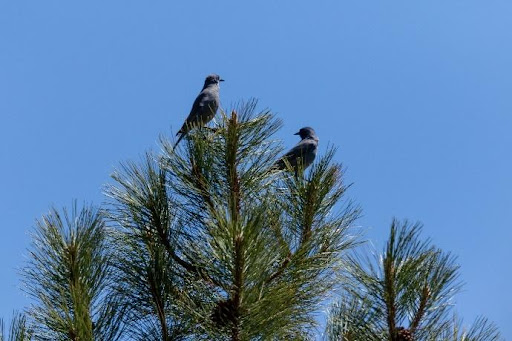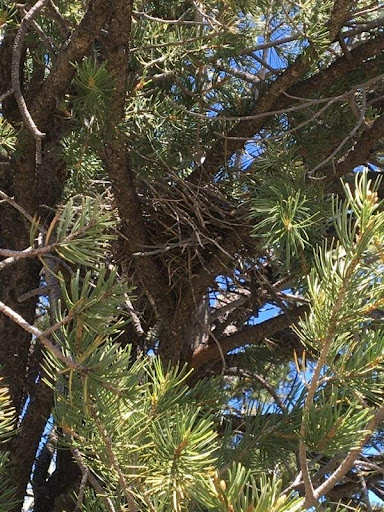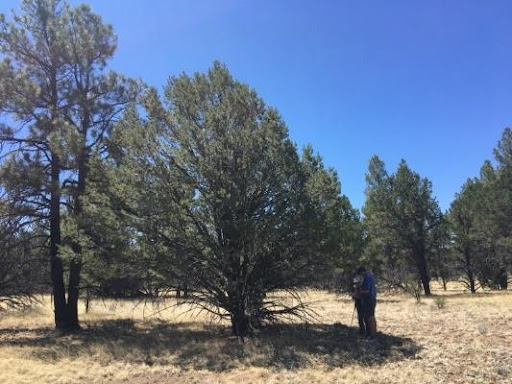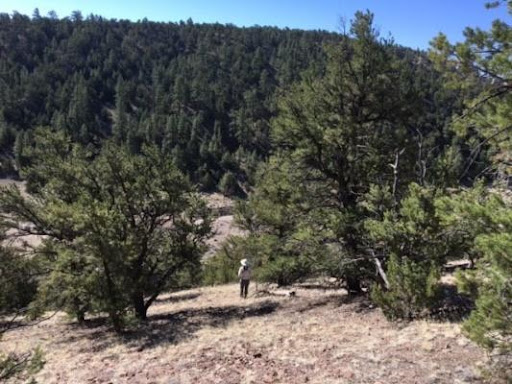Following is a selected project highlight from the Share with Wildlife mission to assist all New Mexico wildlife in need, no matter what species.
Project Highlight: Surveying for a Bird in Decline
Is the Gila National Forest (NF) an area in New Mexico where the Pinyon Jay (Gymnorhinus cyanocephalus) is thriving? What sort of environmental conditions are associated with observations of Pinyon Jays? These are some of the questions that Dr. Kristine Johnson and others working in partnership with Lynn and John Wickersham of Animas Biological Studies are trying to answer with the support of the Share with Wildlife program. Answers will come from the team’s extensive surveys of large, 25km2 survey blocks throughout the Gila NF in southwestern New Mexico. These blocks approximate the size of a Pinyon Jay breeding season home range, or area used by Pinyon Jays to forage, build nests, and seek shelter.
The Pinyon Jay is listed as a Species of Greatest Conservation Need in New Mexico and has been petitioned for listing as threatened or endangered under the Endangered Species Act. This bird plays a very important role in the dispersal of pinyon seeds and thus the regrowth of pinyon trees following tree death driven by fire, drought, or disease. Rangewide, this species declined an estimated 2% annually between 1967 and 2019 and is negatively impacted by a decline in pinyon woodlands and in pinyon nut production. A warming climate is likely partly responsible for these declines, as are forest thinning treatments that significantly reduce pinyon canopy cover. The Gila NF is however one area in New Mexico that has been hypothesized as containing a stable or even increasing population.
This species is challenging to survey for, even during the breeding season, because it covers large distances while foraging and requires a large area for each nesting colony. For this project, in spring 2021 and 2022, researchers drove along roads, looking and listening for Pinyon Jays. They recorded all observations of jays and any associated behavior. They searched for nests in areas where breeding behaviors were detected. At the end of the season, they recorded nest locations and used those locations to delineate colony boundaries.
From the first two years of this project, it is clear that there are notably more Pinyon Jays in the northern and central portions of the Gila NF than in the southern region. Thus for 2022, the focus was on surveying as many survey blocks in these regions with more jays present. There will be a similar geographic focus in upcoming surveys in 2023. Across 2021 and 2022, the Animas Biological Studies team has surveyed 233 survey blocks with Pinyon Jays detected in 89 (~38%) of them, and they have detected 9 nesting colonies. Consideration of environmental conditions thus far shows that Pinyon Jay surveys are more likely to be successful around 8AM and 3PM and that jays seem to have a higher likelihood of being present at sites in the northwestern part of the Gila NF. Interestingly, around 66% of areas where Pinyon Jays were found are in ponderosa pine woodlands; this is the first area in New Mexico where this species has been found in this vegetation type. A third year of data collection in 2023 should allow for further clarification of Pinyon Jay environmental associations.




